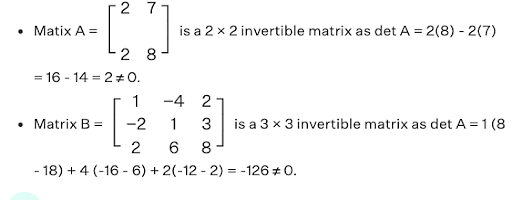Find the inverse of each of the matrices, if it exists.
\(\begin{bmatrix} 3 & 10\\ 2 & 7\end{bmatrix}\)
\(\begin{bmatrix} 3 & 10\\ 2 & 7\end{bmatrix}\)
Solution and Explanation
Let A=\(\begin{bmatrix} 3 & 10\\ 2 & 7\end{bmatrix}\)
We know that \(A = IA \)
\(\begin{bmatrix} 3 & 10\\ 2 & 7\end{bmatrix}\)= \(\begin{bmatrix} 1 & 0\\ 0 & 1\end{bmatrix}\)A
⇒ \(\begin{bmatrix} 1 & 3\\ 2 & 7\end{bmatrix}\)= \(\begin{bmatrix} 1 & -1\\ 0 & 1\end{bmatrix}\)A \((R_1\rightarrow R_1-R_2)\)
⇒ \(\begin{bmatrix} 1 & 3\\ 0 & 1\end{bmatrix}\)= \(\begin{bmatrix} 1 & -1\\ -2 & 3\end{bmatrix}\) A \((R_2\rightarrow R_2-2R_2)\)
⇒ \(\begin{bmatrix} 1 & 0\\ 0 & 1\end{bmatrix}\)= \(\begin{bmatrix} 7 & -10\\ -2 & 3\end{bmatrix}\)\(A\)et \((R_1\rightarrow R_1-3R_2)\)
\(\therefore A^{-1}=\) \(\begin{bmatrix} 7 & -10\\ -2 & 3\end{bmatrix}\)
Top Questions on Matrices
- Find x, y, z if
\[ \begin{bmatrix} 5 & 1 & 0 \\ 1 & 1 & 1 \end{bmatrix} \begin{bmatrix} 0 & 1 & -2 \\ 1 & -2 & 3 \\ -1 & 1 & 1 \end{bmatrix} \begin{bmatrix} x-1 \\ y+1 \\ 2z \end{bmatrix} = \begin{bmatrix} 2 \\ 1 \end{bmatrix}. \] - For all \( n \in \mathbb{N} \), if \( 1^3 + 2^3 + 3^3 + \cdots + n^3>x \), then a value of \( x \) among the following is:
- If $A$ and $B$ are two square matrices each of order 3 with $|A| = 3$ and $|B| = 5$, then $|2AB|$ is:
- If \( \begin{bmatrix} 7 & 0 \\ 0 & 7 \end{bmatrix} \) is a scalar matrix, then \( x^y \) is equal to:
- If $M$ and $N$ are square matrices of order 3 such that $\det(M) = m$ and $MN = mI$, then $\det(N)$ is equal to :
Questions Asked in CBSE CLASS XII exam
- A capacitor is charged by a battery to a potential difference \( V \). It is disconnected from the battery and connected across another identical uncharged capacitor. Calculate the ratio of total energy stored in the combination to the initial energy stored in the capacitor.
- CBSE CLASS XII - 2025
- Capacitors and Capacitance
- “There is a limit to the amount of charge that can be stored on a given capacitor.” Explain.
- CBSE CLASS XII - 2025
- Capacitors and Capacitance
- Mention the number of chromosomes at each stage. Correlate the life phases of the individual with the stages of the process.
- CBSE CLASS XII - 2025
- Pollination
- Consider the Linear Programming Problem, where the objective function \[ Z = x + 4y \] needs to be minimized subject to the following constraints: \[ 2x + y \geq 1000, \] \[ x + 2y \geq 800, \] \[ x \geq 0, \quad y \geq 0. \] Draw a neat graph of the feasible region and find the minimum value of $Z$.
- CBSE CLASS XII - 2025
- Linear Programming Problem
- In the given figure, three identical bulbs P, Q, and S are connected to a battery.

[(i)] Compare the brightness of bulbs P and Q with that of bulb S when key K is closed.
[(ii)] Compare the brightness of the bulbs S and Q when the key K is opened.
Justify your answer in both cases.
- CBSE CLASS XII - 2025
- Current electricity
Concepts Used:
Invertible matrices
A matrix for which matrix inversion operation exists, given that it satisfies the requisite conditions is known as an invertible matrix. Any given square matrix A of order n × n is called invertible if and only if there exists, another n × n square matrix B such that, AB = BA = In, where In is an identity matrix of order n × n.
For example,
It can be observed that the determinant of the following matrices is non-zero.
